by J. Klett, B. Fahey and R. Cox and I. Shonle* (1/18)
Quick Facts…
- A Colorado native tree can be described as existing in Colorado prior to European settlement.
- Native plant communities make Colorado visually distinct from the eastern, southern or western United States.
- Native plant gardens are wildlife habitats and each plant contributes to the biodiversity of the state.
- Landscaping with natives on a large or small scale can maintain biodiversity that otherwise would be lost to development.
Why Grow Native Trees?
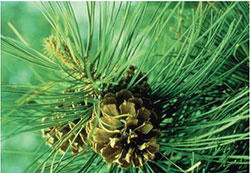 |
| Figure 1: Ponderosa pine cones (Pinus ponderosa) |
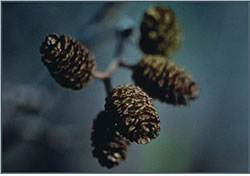 |
| Figure 2: Alder fruit (Alnus tenuifolia) |
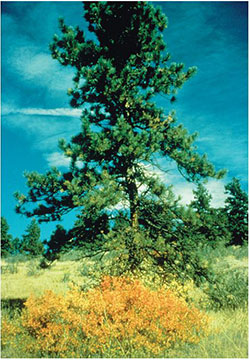 |
| Figure 3: Ponderosa pine (Pinus ponderosa) |
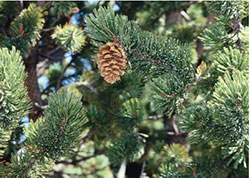 |
| Figure 4: Bristlecone pine (Pinus aristata) |
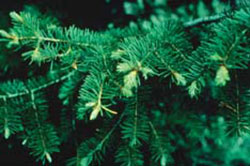 |
| Figure 5: Douglas-fir cone (Pseudotsuga menziesii) |
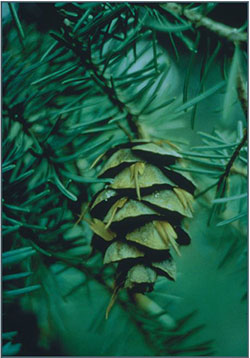 |
| Figure 6: Douglas-fir (Pseudotsuga menziesii) |
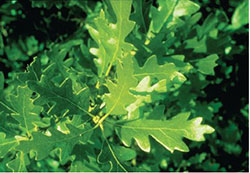 |
| Figure 7: Gambel oak (Quercus gambelii) |
There are many benefits to using Colorado native trees for home and commercial landscapes. Colorado native trees are naturally adapted to their specific Colorado climate, soil, and environmental conditions. When correctly sited, they can be ideal plants for a sustainable landscape that requires reduced external inputs such as watering, fertilizing, and pruning. In order to realize these benefits, the planting site must approximate the natural environmental conditions of the plant in its native habitat.
Another benefit of using Colorado native trees in landscapes is that they attract a wide variety of wildlife including mammals, birds, and butterflies. Rapid urbanization in the state is reducing biodiversity as habitat is removed for building and road construction. Landscaping with natives on a large or small scale can maintain biodiversity that otherwise could be lost to development.
The trees listed in Table 1 are grown by some Colorado nurseries and are becoming more available in the commercial sector. However, not all trees listed are available at all nurseries, so you may need to contact several commercial outlets to find a specific plant. If a tree is not sold in the trade, asking for it may help increase its availability. Native trees should not be collected from the wild because this reduces the biodiversity and causes a disturbed area that may be invaded by weeds.
Most of the trees listed in Table 1 are available as container-grown plants. Native trees often do not have as great a visual impact in the container or immediately after planting as do traditional horticultural species. Over time, they reward the homeowner with their natural beauty and other benefits.
Where To Grow Native Trees
There are several factors to consider when designing a native landscape. Due to Colorado’s variation of elevation and topography, native plants are found in many habitats. In order to maximize survival with minimal external inputs, trees should be selected to match the site’s life
zone and the plant’s moisture, light, and soil requirements. Even if a plant is listed for a particular life zone, the aspect (north, south, east, or west facing) of the proposed site should match the moisture requirement. For example, a Colorado blue spruce, which has a high moisture requirement, should not be sited with plants of dissimilar water needs. Similarly, a Colorado blue spruce should not be planted on a south-facing slope, where a significant amount of additional moisture would be required.
Growing native trees does not exclude the use of adapted non-native plants. There are many non-native plants that are adapted to Colorado’s climate and can be used in a native landscape as long as moisture, light, and soil requirements are similar. If a site has a non-native landscape that
requires additional inputs (such as an irrigated landscape on the plains), dry land native plants can be used in non-irrigated pockets within the non-native landscape. These native “pocket gardens” can be located in areas such as parkways and next to hardscapes that are difficult to irrigate.
Some communities regulate landscape appearance or the type of plants that may be used. So before completing a landscape design, check with local authorities, including homeowner’s associations, to discover any regulations that may affect your design.
Life Zones of Colorado
Colorado can be divided into five life zones that are broadly defined by the plant communities that occur at the approximate elevations described below. The Plains life zone, 3,500 to 5,500 feet, is located in eastern Colorado where the majority of Colorado’s population resides. It is dominated by grasslands and streamside cottonwoods. In western Colorado, the Upper Sonoran life zone is located at altitudes below 7,000 feet, and in the San Luis Valley, below 8,000 feet. This zone is characterized by semi desert shrublands and piñon pine-juniper woodlands at its upper limit.
The Foothills life zone occurs from 5,500 to 8,000 feet and is dominated by dry land shrubs such as Gambel oak and mountain-mahogany, and in southern and western Colorado, piñon-juniper woodlands and sagebrush. The Montane zone consists of ponderosa pine, Douglas-fir, lodgepole pine, and aspen woodlands at elevations of 8,000 to 9,500 feet. Dense forests of Subalpine fir and Engelmann spruce dominate the subalpine zone at 9,500 to 11,500 feet. The Alpine zone above 11,500 feet is a treeless zone made up of grasslands called tundra. Species requiring medium to high moisture occur along watercourses throughout all zones.
Culture and Maintenance
Successful establishment of native trees may require supplemental moisture after planting. Once established, the watering frequency can be reduced or eliminated, if the plant was sited in its native environmental conditions. Container-grown trees can be planted at any time during the growing season. Container-grown native trees are often grown in a soiless mixture of peat
and bark, so the planting site should be amended with some organic material. Another option would be to carefully wash off the media from the container grown plant and plant it bare root.
Using native trees offers many benefits in addition to reduced maintenance. Natives are part of our natural heritage and the ecosystems of Colorado. Native plant communities make Colorado visually distinct from the eastern, southern, or western United States. Native plant gardens are wildlife habitats and each plant contributes to the biodiversity of the state.
| Table 1. Native trees for Colorado landscapes. | ||||||
| Scientific Name1 | Common Name(s) | Planting Altitude in feet2 | Native Colorado Life Zone3 | Moisture4 | Evergreen/ Deciduous | Comments5 |
|
Large trees (45+ ft when mature)
|
||||||
| Abies concolor | white fir, concolor fir | 4,000 – 10,000 | Foothills – Montane | M – H | E | symmetrical, pyramidal shape; for large landscapes; attractive soft, blue-green needles; grows best where protected from wind. |
| Abies lasiocarpa arizonica | corkbark fir, subalpine fir | 7,000 – 11,000 | Montane – Subalpine | M – H | E | narrow, pyramidal habit, blue-green needles, corky white bark;less commonly available; potential for use at lower elevations. |
| Acer negundo | boxelder | 4,500 – 7,500 | Plains – FoothillsUpper Sonoran | M – H | D | maple with compound leaves found along streams; rapid grower, weak-wooded, short-lived; female trees attract nuisance boxelder bugs. |
| Picea engelmannii | Engelmann spruce | 5,000 – 11,000 | Montane – Subalpine | M – H | E | large, densely pyramidal tree with blue-green needles and reddish scaly bark when mature; found at high elevations with subalpine fir where it performs best; less commonly available. |
| Picea pungens | Colorado spruce | 4,000 – 9,500 | Foothills – Montane | M – H | E | Colorado State Tree; sharp, stiff needles ranging from green to silvery blue; horizontal branching. |
| Pinus contorta latifolia | lodgepole pine | 6,000 – 11,000 | Montane – Subalpine | M | E | light green needles, persistent cones; tall, narrow form in native habitat; broader habit in landscape site; requires well-drained soils. |
| Pinus flexilis | limber pine | 4,000 -10,000 | Montane – Subalpine | L – M | E | green to blue-green needles in bundles of 4-5; flexible twigs; larger, ornamental cones. |
| Pinus ponderosa | ponderosa pine | 4,000 – 9,000 | Foothills – Montane | L – M | E | longer, yellow-green needles; bark becomes cinnamon color with age; vanilla fragrance on warm days. |
| Pinus strobiformis | Southwestern white pine | 4,000 – 8,500 | Foothills – Montane | L – M | E | blue-green needles, large cones, scaly bark when mature, faster-growing, less commonly available. |
| Populus angustifolia | narrowleaf cottonwood | 4,000 – 9,500 | Foothills – Montane | H | D | vertical growth habit; willow-like leaves, suckers heavily, best in natural areas along streams; males do not produce cotton; yellow fall color. |
| Populus sargentii | Plains cottonwood | 4,000 – 7,000 | Plains – FoothillsUpper Sonoran | H | D | fast-growing, broad, irregular canopy; triangular leaves; males do not produce cotton. |
| Populus x acuminata | lanceleaf cottonwood | 4,500 – 8,500 | Foothills | H | D | fast-growing, upright, rounded, dense branching; spear-shaped, drooping leaves; less suckering; natural hybrid between Plains and narrowleaf cottonwoods; males do not produce cotton. |
| Pseudotsuga menziesii | Douglas-fir | 4,500 – 11,000 | Foothills – Montane | M | E | fast-growing; soft, medium to dark green needles; pyramidal shape; unique cones; alternate host for gall insects on spruce. |
|
Small – Medium trees (10-45 ft when mature
|
||||||
| Acer grandidentatum | bigtooth maple, Wasatch maple | 4,500 -7,000 | Foothills – Montane3a | L – M | D | native to southwest, with occurrences in Montezuma County; often multi-stem form; degree of orange-red fall color varies. |
| Alnus tenuifolia | thinleaf alder | 5,000 – 10,000 | Foothills – Subalpine | H | D | large shrub or small tree, often multi-stemmed; yellow fall color not reliable; persistent fruits resemble miniature pine cones, found along streams; bark gray; sun to part shade. |
| Betula occidentalis (Betula fontinalis) |
Western water birch, Rocky Mountain birch | 5,000 – 9,000 | Foothills – Montane | H | D | small tree or large shrub; bronze-red bark; found along streams, often with thinleaf alder; yellow fall color; requires additional moisture in dry winters. |
| Juniperus monosperma | oneseed juniper | 4,000 – 7,500 | Plains – Foothills3b | L | E | multi-stemmed tree with small, scale-like leaves, found on dry rocky slopes, often with pinon. |
| Juniperus osteosperma | Utah juniper | 5,000 – 9,000 | Upper Sonoran –Foothills3a | L | E | spreading, multi-stemmed evergreen with small, scale-like leaves; large, grayish-blue berry-like fruits are important food for small mammals and birds. |
| Juniperus scopulorum | Rocky Mountain juniper | 4,000 – 8,000 | Foothills – Montane | L | E | variable growth habit, often upright to columnar; male and female flowers on separate plants; found on dry mountain slopes and mesas; berry-like fruit important food for small mammals and birds. |
| Pinus aristata | bristlecone pine | 5,000 – 11,000 | Montane – Subalpine | L – M | E | rounded to pyramidal shape; branches have bottlebrush appearance; short, dark-green needles with specks of white resin; spiny cones; needs well-drained soil; slow-growing. |
| Pinus edulis | pinon, pinyon pine | 4,000 – 7,500 | Foothills – MontaneUpper Sonoran | L | E | compact, bushy growth form with grayish green needles in bundles of two, small rounded cones; edible seeds develop when planted in grove for cross-pollination; best in dry, well-drained site. |
| Populus tremuloides | quaking aspen | 4,000 – 10,000 | Foothills – Subalpine | H | D | slender branches, white bark with black ridges in maturity; golden fall color, leaves flutter in slight breeze; short-lived, suckers; best in well-drained mountain soils. |
| Quercus gambelii | Gambel oak, scrub oak | 4,000 – 8,500 | Foothills – Montane | L – M | D | small tree to large shrub, best on well-drained soils; often thicket-forming; shades of red, orange, yellow and brown in fall; acorns provide excellent wildlife food. |
| Salix amygdaloides | peachleaf willow | 3,500 – 7,000 | Plains – FoothillsUpper Sonoran | H | D | fast-growing; lance-shaped leaves; new twig growth orange-yellow; ascending branches; found along streams. |
| 1As commonly sold in the trade. For equivalents, see botanical publications. |
||||||
| 2 Planting altitudes are estimates of where plants may be successfully grown as landscape plants. In many cases, species may be successfully planted at a lower zone with supplemental irrigation or a higher zone with protection. | ||||||
| 3 Approximate life zone elevations: Plains – below 5,500 ft. in eastern CO; Upper Sonoran – below 7,000 ft. in western CO and below 8,000 ft. in San Luis Valley; Foothills – 5,500 – 8,000 ft.; Montane – 8,000 – 9,500 ft.; Subalpine – 9,500 – 11,500 ft.; Alpine – above 11,500 ft. Species requiring medium to high moisture occur along watercourses throughout all zones. For simplicity, life zones were taken from Grassland to Glacier by Mutel and Emerick, first edition, 1984. For a more detailed treatment of Colorado ecosystems, see second edition, 1992. |
||||||
| 3aNative to Western Slope; 3bNative to Eastern Slope. |
||||||
| 4 Moisture Requirement: L – Low, M – Moderate, H – High. |
||||||
| 5 Except where noted, plants prefer full sun. | ||||||
*J. Klett, Colorado State University Extension landscape and horticulture specialist; B. Fahey, Jefferson County Extension natural resources/horticulture agent; R. Cox, Arapahoe County Extension horticulture agent., retired, and I. Shonle, Gilpin County Extension Director/Agent. 7/02. Revised 1/18.
Colorado State University, U.S. Department of Agriculture, and Colorado counties cooperating. CSU Extension programs are available to all without discrimination. No endorsement of products mentioned is intended nor is criticism implied of products not mentioned.
Go to top of this page.





